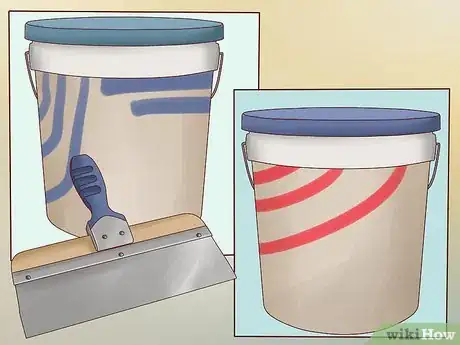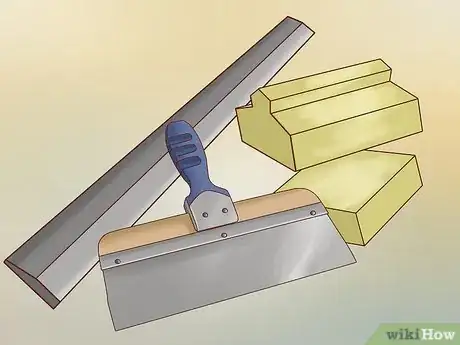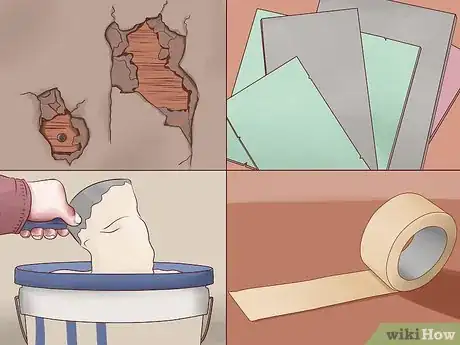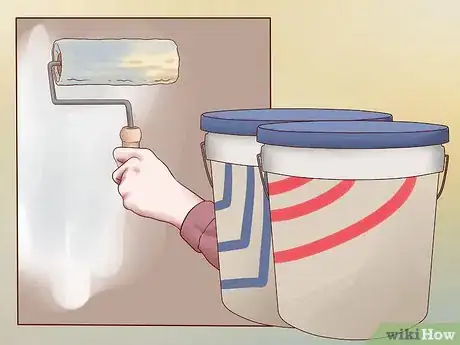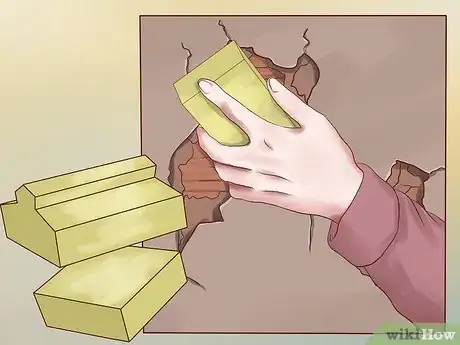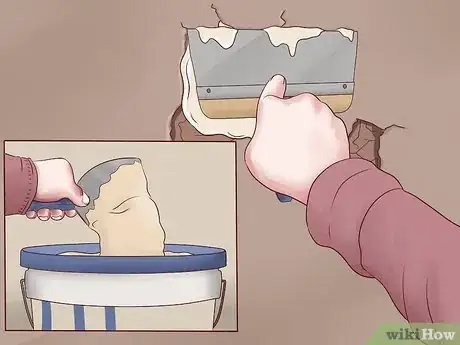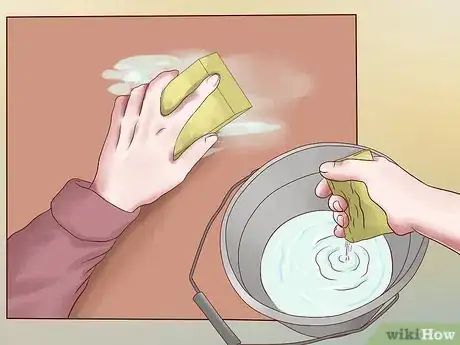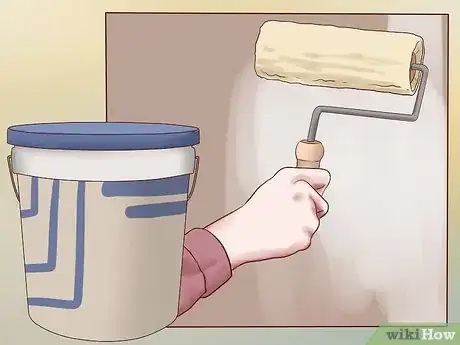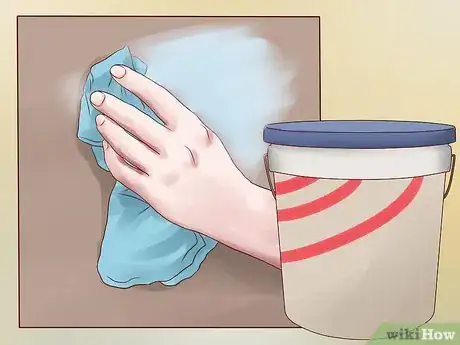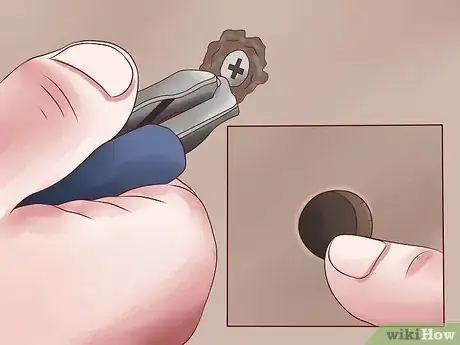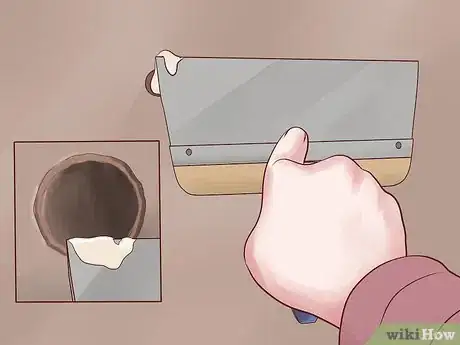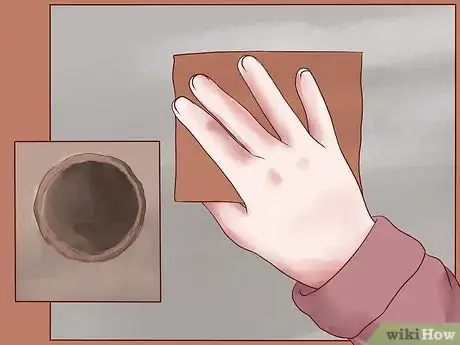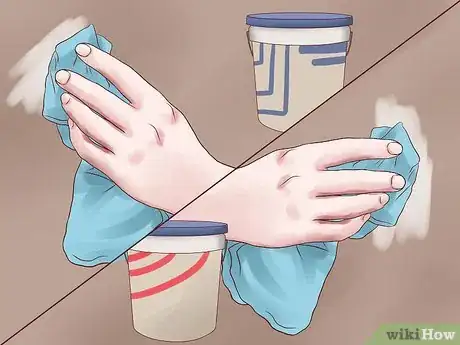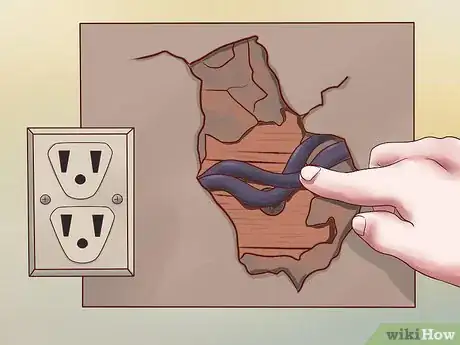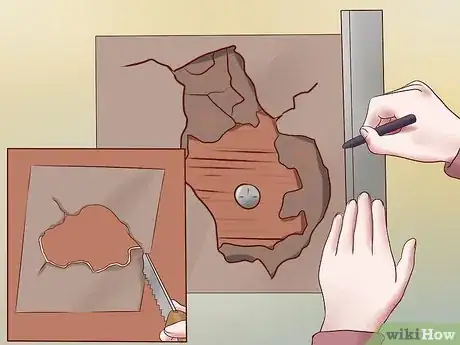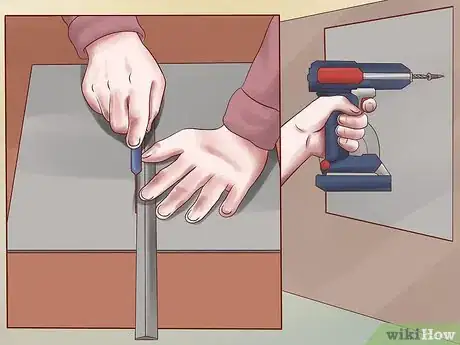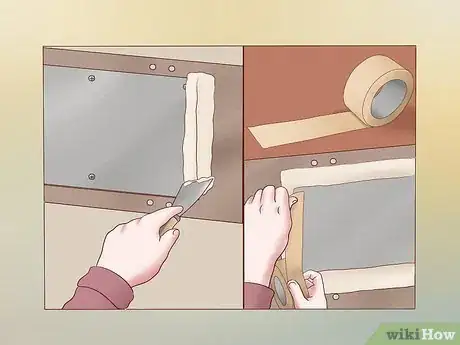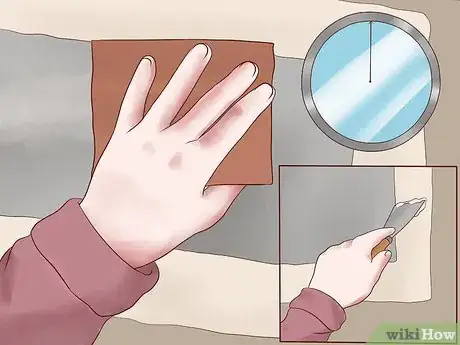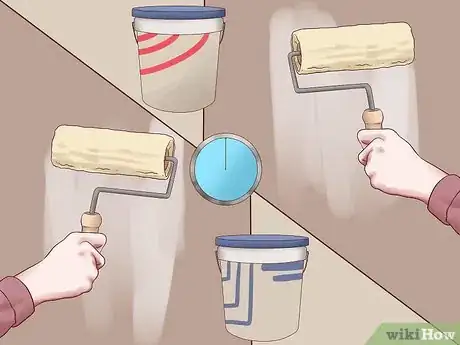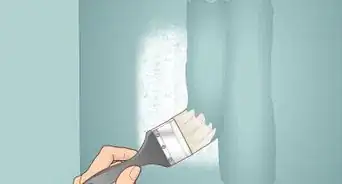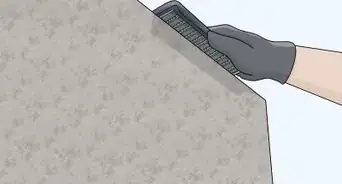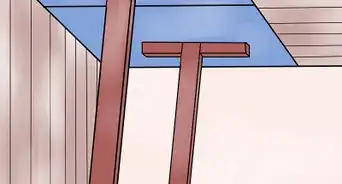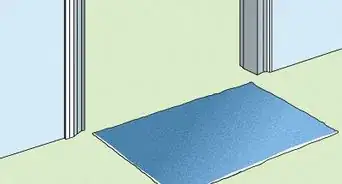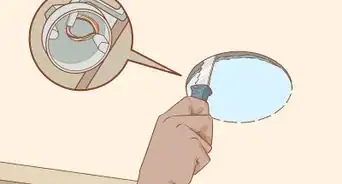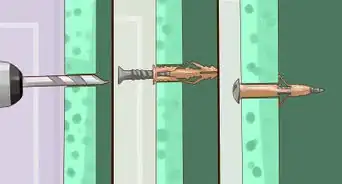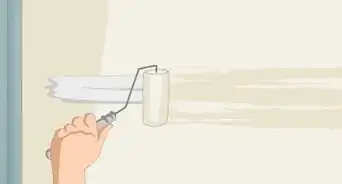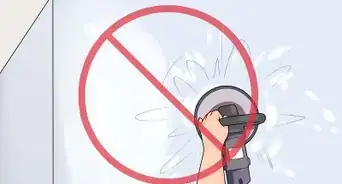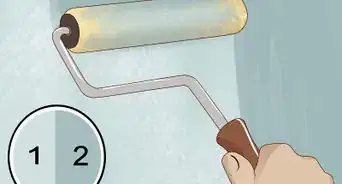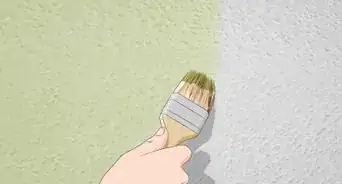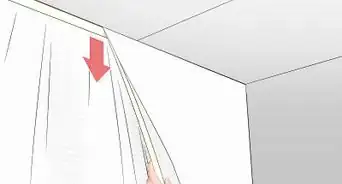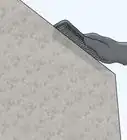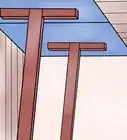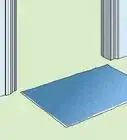This article was co-authored by Sam Adams. Sam Adams is the owner of Cherry Design + Build, a residential design and construction firm, which has been operating in the Greater Seattle Area for over 13 years. A former architect, Sam is now a full-service contractor, specializing in residential remodels and additions.
This article has been viewed 80,457 times.
Drywall is the most commonly used material for interior walls. Since it's a relatively soft material it is prone to getting damaged, but it's also quite easy for a homeowner to repair. Read on for information on how to fill dents and patch small and large holes.
Steps
Choosing Drywall Repair Supplies
-
1Purchase a joint compound. The two commonly available joint compounds are lightweight and all-purpose. Lightweight compound dries quicker than all-purpose and requires less sanding.[1]
- Joint compound comes in a variety of container sizes, but be advised that smaller containers may cost just as much as the larger ones. If resealed properly, joint compound can be kept for up to 9 months for other around-the-house repairs if you end up with leftover compound.
-
2Get compound applicators and sanders. A joint knife and a metal straightedge will enable you to apply the joint compound smoothly and scrape away the excess, so the repair job will look professional instead of lumpy or uneven. Get a sanding sponge to even out the surface after the joint compound has dried.Advertisement
-
3Buy patching supplies for larger holes. For big holes, you'll need a new piece of drywall to create a patch. Get backing boards, which hold the drywall in place, and purchase a piece of drywall large enough to fill the hole. You'll need paper tape and joint compound to smooth out the joints.
-
4Get paint and primer. The final step to repairing drywall is painting the repaired area so that it matches the rest of the wall. Use the same primer and paint you originally used to paint the wall.[2]
Filling a Dent
-
1Sand down the edges. Use a sanding sponge to sand away the loose particles around the edges of the dent. Run the sanding sponge over the dent itself to create a rough surface that the joint compound, which is used to fill the dent, will be able to adhere to easily.
-
2Apply joint compound. Dip a joint knife sideways into the container of joint compound and load about half of the blade. Run the knife over the dented area to smooth on the joint compound. Turn the blade at a 90 degree angle to the wall and run it over the area again to remove excess compound.
- Be sure to remove the extra compound, so that the area won't have bumps once the the substance dries.
- Check the area it it dries to determine if the dent has been completely filled. You may need to apply a second coat if the joint compound shrinks as it dries.
-
3Sand the area. Use a sponge sander or another fine sander to gently blend the area with the surrounding wall space after the joint compound has completely dried. You can also use a dampened sponge to smooth the edges.[3]
-
4Prime the area. Joint compounds are relatively porous, so it's necessary to prime the repaired area before you paint it. Otherwise, the paint will look different from the surrounding area.[4]
- Use a primer that matches the paint color. If possible, use the same one you originally used to paint the wall.
- If you have paint that also acts as a primer, priming the wall first isn't necessary.
-
5Paint over the repair. Once the primer is dry, use a soft cloth to paint over the area with the wall paint. Work gently and use strokes similar to the strokes you used to paint the surrounding wall so that the paint will look blended after it has dried.[5]
Patching a Nail Hole
-
1Remove the loose edges. If parts of the drywall are sticking out from when the nail was removed, gently scrape them off or push them into the hole. Make sure the edges of the hole are flush with the wall, so there won't be any bumps or lumps after you repair the area.[6]
-
2Fill the hole with joint compound. Load the joint knife with joint compound and push the compound into the hole. Scrape away the excess compound by holding the knife at a ninety-degree angle from the wall and running it over the surface of the hole.
- Try not to get joint compound on the wall surrounding the hole, since it will dry and affect the paint in the area. Load the knife with only as much compound as you need to fill the hole.
- If you get joint compound on the wall area surrounding the nail as you work, wipe it away with a damp cloth.
-
3Sand the patch. Use fine-grit sandpaper to sand the area once the compound has completely dried. Use a damp cloth to wipe away the dust when you're finished. The wall surface where the hole was should now be completely smooth.
-
4Prime and paint the area. For a perfectly seamless repair, use a soft cloth to dab a bit of primer over the repaired area. When it's dry, use another cloth to dab wall paint over the area.[7]
Patching a Larger Hole
-
1Check for wires. If the hole is close to an electrical outlet or phone line, make sure you check inside it so you don't hit any wires while you work. Feel around the hole with your hands, or peer inside using a flashlight.
- If you find a wire, take note of where it is located and plan to work carefully around it when you repair the hole.
-
2Cut a rectangle. Use a ruler and a level to measure and draw a rectangle around the perimeter of the hole, then cut it out using a utility knife or drywall saw. This will enable you to neatly patch the hole with a piece of drywall the precise size you need, rather than making an irregular patch.
-
3Add backer boards. Cut the backer boards about 4 inches (10.2 cm) longer than the height of the hole. Line the first backer board vertically along the left edge of the hole. Use one hand to hold it in place tightly while using a drill to screw two drywall screws through the intact drywall just below the hole, and two through the drywall just above the hole. Use the same technique to install another backer board along the right edge of the hole.
- Pine or other soft wood backer boards work well for repairing drywall, since they're easy to screw into.
- Be sure to hold the boards in such a way that the screws won't scratch or puncture your hands when they pop through the backer boards.
-
4Install a drywall patch. Measure the thickness of the drywall and purchase a piece of drywall large enough to patch the hole. Cut it to size using the drywall saw so that it will fit neatly into the hole. Place the drywall patch into the hole and screw it into the backing boards on either side, spacing the screws 6 inches (15.2 cm) apart.
- Most hardware and home goods stores sell scraps of drywall in different shapes and sizes. Look for one large enough to patch your hole so you don't have to buy a complete sheet of drywall, which will probably be more than you need.
-
5Tape the joints. Load a joint knife with joint compound and apply it to joints, the seams where the patch and the wall connect. Quickly apply paper tape to the joints and use a taping knife to smooth the tape into place, making sure there are no bubbles or lumps. Apply a second coating of joint compound and let it dry.
- You can add a little water to the compound to thin it out, making it easier to spread and feather out along the wall for even blending.
- Be sure to remove excess compound as you go, so that the transition between the patch and the wall is as smooth as possible. Pull the taping knife in one direction.
- Laying the tape evenly can be tricky. It's worth starting over if you lay it crookedly, since the tape is important for blending the patch with the wall.
-
6Sand the area and add another coat. Once the first few coats are dry, smooth the edges by sanding them with a fine grit sandpaper. Fill in any gouges and uneven areas by applying another thin coat of compound. Let that dry, and continue sanding and adding more compound until the surface is even and smooth.
- Wait at least 24 hours between sandings. The compound should be completely dry, or you may create more ruts and gouges instead of smoothing the surface.
-
7Prime and paint the area. After the last sanding, use a primer to get the area ready for painting. When the primer is dry, paint the area using the same brush or paint applicator you originally used to paint the wall.[8]
Expert Q&A
-
QuestionWhat kind of primer is best for a drywall repair on unfinished walls?
 Sam AdamsSam Adams is the owner of Cherry Design + Build, a residential design and construction firm, which has been operating in the Greater Seattle Area for over 13 years. A former architect, Sam is now a full-service contractor, specializing in residential remodels and additions.
Sam AdamsSam Adams is the owner of Cherry Design + Build, a residential design and construction firm, which has been operating in the Greater Seattle Area for over 13 years. A former architect, Sam is now a full-service contractor, specializing in residential remodels and additions.
Professional Contractor The best option is a primer called PVA. It stands for polyvinyl chloride. It's formulated specifically for fresh drywall, and it's actually cheaper than regular primer.
The best option is a primer called PVA. It stands for polyvinyl chloride. It's formulated specifically for fresh drywall, and it's actually cheaper than regular primer. -
QuestionWhy does the plaster and tape keep peeling and cracking after a couple of days?
 Community AnswerYou're probably putting your mud on too thick. Use thin layers of joint compound and let it dry completely between coats.
Community AnswerYou're probably putting your mud on too thick. Use thin layers of joint compound and let it dry completely between coats.
Things You'll Need
- Drop cloth
- Joint compound
- Sandpaper
- Fine-grit drywall sandpaper
- Backing boards
- Drywall saw
- Drywall screws
- Drill
- Repair patch
- Putty knife
- Mask
References
- ↑ Sam Adams. Professional Contractor. Expert Interview. 4 June 2019.
- ↑ Sam Adams. Professional Contractor. Expert Interview. 4 June 2019.
- ↑ http://www.lowes.com/cd_Patch+and+Repair+Drywall_498789296_
- ↑ Sam Adams. Professional Contractor. Expert Interview. 4 June 2019.
- ↑ Sam Adams. Professional Contractor. Expert Interview. 4 June 2019.
- ↑ http://www.lowes.com/cd_Patch+and+Repair+Drywall_498789296_
- ↑ Sam Adams. Professional Contractor. Expert Interview. 4 June 2019.
- ↑ Sam Adams. Professional Contractor. Expert Interview. 4 June 2019.
About This Article
To fix a nail hole in drywall, start by scraping off any loose edges around the hole so the edges of the hole are flush with the wall. Then, use a joint knife to press joint compound into the hole. Once the hole is full, scrape off the excess compound with the joint knife and wait for the compound to completely dry. Next, sand the hole and surrounding area with fine-grit sandpaper so the surface of the wall is completely smooth. Finally, prime and paint the area so it blends in with the rest of the wall. To learn how to repair big holes in drywall, scroll down!
